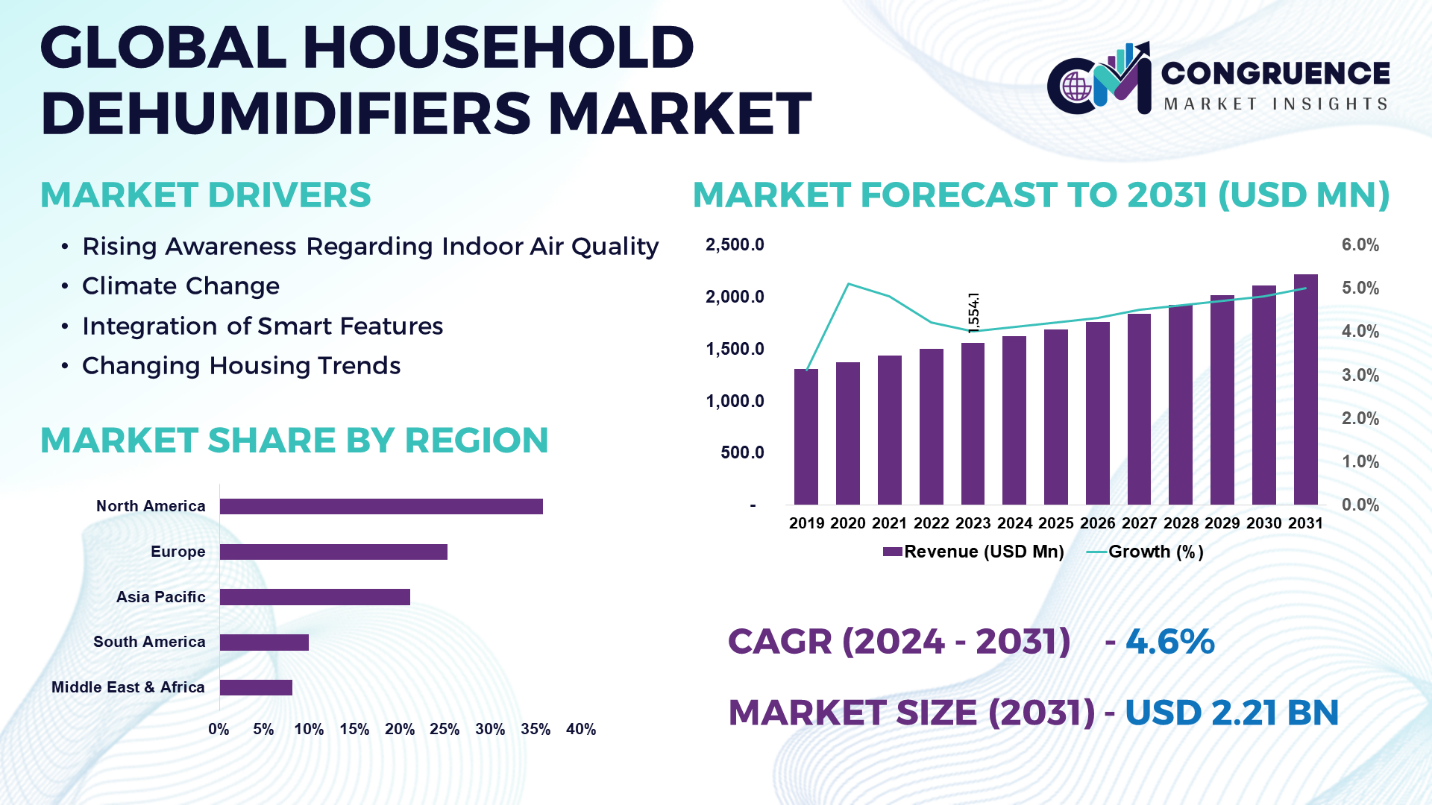Reports
The Global Household Dehumidifiers Market was valued at USD 1,554.1 Million in 2023 and is anticipated to reach a value of USD 2,214.2 Million by 2031 expanding at a CAGR of 4.6% between 2024 and 2031.
Dehumidifiers are machines designed to decrease and keep up the level of humidity within the air inside a particular area. These appliances are usually utilized in homes, commercial buildings, industrial offices, and other buildings in order to avoid issues such as mold development, smelly odors, and damage to delicate materials. Household dehumidifiers are those dehumidifiers that are used and available to common public which can be used at home and keep the humidity of the house under check. Cases of various respiratory diseases are on the upward trajectory due to humid air. This is due to the fact that various allergens such as mold, mildew, and dust mites grow into highly humid environment. Humidity provides water to these allergens which is a primary cause for their rapid growth. This causes various chronic diseases to the people living in that environment. Besides this, technological advancements ensure prevalence of energy-efficient dehumidification systems and smart connectivity features in household dehumidifier, driving the adoption of household dehumidifier.

Household Dehumidifiers Market Major Driving Forces
Rising Awareness Regarding Indoor Air Quality: People across the world are now very conscious and aware regarding their indoor air quality. This is owing to the rising cases of chronic diseases occurring due to poor indoor air quality.
Climate Change: Climate change has created a situation of rise in temperature and rise in humidity across the globe especially in residential areas. This created a need for development of household dehumidifiers to maintain indoor air quality.
Integration of Smart Features: Household dehumidifier is undergoing constant technological innovations and developments. Thus, these household dehumidifiers are now coming up with various advance features such as programmable settings, remote monitoring, and connectivity with smart home systems, driving its demand.
Changing Housing Trends: In recent times, there is an upward trend of construction of tightly sealed residential buildings which are devoid of natural ventilations. Such situations cause increased susceptibility to indoor humidity issues.
Household Dehumidifiers Market Key Opportunities
Growing Concern about Health: There is a rise in concern among the people regarding their health and wellbeing of their residential environment. Thus manufacturers can position themselves and promote household dehumidifiers as essential appliances for creating healthier environment.
Online Retail and E-commerce Growth: The continued development of online retail and e-commerce platforms gives an opportunity for household dehumidifiers producers to grow their reach and tap into a broader client base. Online sales channels permit for simpler product availability and worldwide market infiltration.
Integration with Smart Home Ecosystems: The unification of smart home structures and household dehumidifiers as part of the smart home ecosystem and automated home systems provides creative chances for further functionality and approachability. Enabling voice assistant compatibility, mobile app support, and remote monitoring functions may be attractive to more technologically inclined consumer base.
Household Dehumidifiers Market Key Trends
· Developing awareness among customers regarding the significance of keeping up good indoor air quality.
· The construction industry's development, particularly in residential and commercial segments, leads to heightened requirement for dehumidifiers.
· Changes in climate patterns and an increment in extreme climate occasions can contribute to higher humidity levels.
· locales encountering more frequent and strong humidity may see a more noteworthy demand for dehumidifiers.
· Progressing advancements in dehumidifier innovation, such as energy-efficient models, smart controls, and integration with domestic automation systems.
· Concerns related to respiratory wellbeing and hypersensitivities due to mold, mildew, and dust mites flourish in muggy situations.
Region-wise Market Insights
North America accounted for the largest market share at 35.7% in 2023 whereas, Asia Pacific is expected to register the fastest growth, expanding at a CAGR of 5.2% between 2024 and 2031.

North America dominates the global household dehumidifier market with the huge market share of 35.7%. The market of this region is driven by several factors; some of them includes higher disposable income, high awareness of indoor air quality issues and high technological adoption among the consumers. Asia-Pacific region, on the other hand, is another very prominent region in the global household dehumidifier market with the market share of 21.1%. Although the region’s market share is low, but it is the fastest growing region with the expected CAGR of 5.2% during the projected period of time frame. The market of this region is driven by rapid urbanization, changing lifestyles, and increasing disposable incomes. This region is affected by monsoon, hence, there is greater probability of poor indoor air quality of the region. Europe holds the second highest market share in household dehumidifier market. European countries such as United Kingdom, France, Germany and others have damp climate conditions which facilitates the growth of mold, mildew, and dust mites. Besides this, growing awareness of health implications associated with indoor humidity drives the market in this region.
Market Competition Landscape
The global household dehumidifiers market is characterized by high degree of competition among a large number of manufacturers. Key players in the household dehumidifiers market includes presence of established manufacturers, emerging players, and niche specialists engage in strategies aimed at gaining a competitive edge. Established brands leverage their brand reputation, technological expertise, and distribution networks to maintain market dominance, while newer entrants focus on innovative solutions tailored to specific market niches or geographic regions. E-commerce and online retailing has intensified market and is crucial in reshaping distribution networks, thus offering a platform for both established and emerging brands to reach a wider customer base. Key players in the global household dehumidifiers market implement various organic and inorganic strategies to strengthen and improve their market positioning. Organic strategies include product innovation and development, brand building and marketing, market expansion and penetration operational efficiency and cost optimization and others. Inorganic strategies include mergers and acquisitions, and collaborations and partnerships. Prominent players in the market include:
· Frigidaire (Electrolux)
· Haier Group Corporation
· Honeywell International Inc.
· LG Electronics Inc.
· Mitsubishi Electric Corporation
· Panasonic Corporation
· Midea Group Co., Ltd.
· Danby Products Inc.
· Ebac Ltd.
· Sunpentown International Inc.
· Whirlpool Corporation
· Hisense Group
· De'Longhi Group
· Thermionics Corporation
· GE Appliances (a Haier company)
|
Report Attribute/Metric |
Details |
|
Market Revenue in 2023 |
USD 1,554.1 Million |
|
Market Revenue in 2031 |
USD 2,214.2 Million |
|
CAGR (2024 – 2031) |
4.6% |
|
Base Year |
2023 |
|
Forecast Period |
2024 – 2031 |
|
Historical Data |
2019 to 2023 |
|
Forecast Unit |
Value (US$ Mn) |
|
Key Report Deliverable |
Revenue Forecast, Growth Trends, Market Dynamics, Segmental Overview, Regional and Country-wise Analysis, Competition Landscape |
|
Segments Covered |
· By Type (Portable Dehumidifiers, Whole-House Dehumidifiers) · By Technology (Refrigeration Dehumidifiers, Desiccant Dehumidifiers) · By Capacity (Small, Medium, Large) · By Distribution Channel (Online, Offline) |
|
Geographies Covered |
North America: U.S., Canada and Mexico Europe: Germany, France, U.K., Italy, Spain, and Rest of Europe Asia Pacific: China, India, Japan, South Korea, Southeast Asia, and Rest of Asia Pacific South America: Brazil, Argentina, and Rest of Latin America Middle East & Africa: GCC Countries, South Africa, and Rest of Middle East & Africa |
|
Key Players Analyzed |
Frigidaire (Electrolux), Haier Group Corporation, Honeywell International Inc., LG Electronics Inc., Mitsubishi Electric Corporation, Panasonic Corporation, Midea Group Co., Ltd., Danby Products Inc., Ebac Ltd., Sunpentown International Inc., Whirlpool Corporation, Hisense Group, De'Longhi Group, Thermionics Corporation, GE Appliances (a Haier company). |
|
Customization & Pricing |
Available on Request (10% Customization is Free) |
